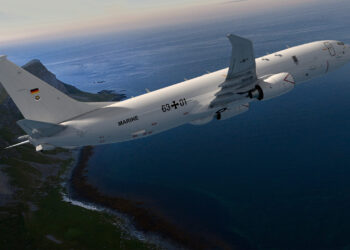Lockheed Martin,
OWEGO, NY: Lockheed Martin has received a $3 million contract from the Office of Naval Research to develop and demonstrate a mission management system that will enable U.S. Navy ships, helicopters and unmanned vehicles to collaborate as a team when mine hunting in shallow coastal waters.
The contract is part of a U.S. Navy initiative to explore how the next-generation expeditionary warship — the Littoral Combat Ship (LCS) — could adopt advances in manned/unmanned teaming for mine countermeasures operations. Today, multiple shipboard operators are assigned control of an individual, independently-controlled unmanned Remote Multi Mission Vehicle (RMMV), which tows a sensor through the water to locate and identify mines. The new approach will determine how to automate management of multiple RMMVs by fewer operators, while also enabling the vehicles to perform as a collaborative team. The same system also would reduce workload when communicating with manned MH-60S airborne mine countermeasures helicopters, which will carry systems that locate and neutralize mines.
The Office of Naval Research calls the development and demonstration program TEAM — for Team-based Execution of Autonomous Missions — and has called for a simulated demonstration in 18 months that depicts the system’s ability to command and control a mine hunting team from a single LCS. The Navy has the option to fund an additional $1.1 million in FY2009 that would demonstrate collaboration among LCS squadrons, as well as integration with flight deck and crew scheduling activities.
“Our objective is to help the Navy streamline mine countermeasures operations to the point where a smaller number of ship-based operators can command and control a team of helicopters and waterborne RMMVs, as compared to conventional methods,” said Dr. Robert Szczerba, TEAM principal engineer at Lockheed Martin Systems Integration in Owego, NY. “Our ‘mission-centric’ approach will allow these and future platforms to coordinate tasks among themselves to a high degree of autonomy and with minimal human oversight for substantially improved overall mission effectiveness.”
The TEAM system is based on the KineForce mission management system developed by Lockheed Martin. The system will allow the mine countermeasures operator aboard the host ship to define and monitor the mission plans of the manned and unmanned vehicle teams. Aboard each unmanned vehicle, the system will sense and understand changes to the battlefield environment, prioritize tasks to meet mission objectives, and detect and react to threats.
“When multiple unmanned vehicles can control their own movements and coordinate tasks with manned platforms in a rapidly changing and unscripted environment, the LCS operator is free to manage the operation, view the mission within the context of the overall battlefield picture, and physically engage only to handle the important decisions,” said Szczerba.
Lockheed Martin Systems Integration – Owego will lead the TEAM program with support from Lockheed Martin Advanced Technology Laboratories (ATL) and Lockheed Martin Maritime Sensors and Systems (MS2).
The TEAM award complements a $2.4-million Office of Naval Research contract in April to ATL, which will build a collaborative display system for the mine countermeasures operators aboard the LCS. Designated SUMMIT (Supervision of Unmanned vehicles Mission Management by Interactive Teams), the program will allow operators to easily view and share mission information and tasks during mine countermeasures operations.
Headquartered in Bethesda, Md., Lockheed Martin employs about 140,000 people worldwide and is principally engaged in the research, design, development, manufacture, integration and sustainment of advanced technology systems, products and services. The Corporation reported 2007 sales of $41.9 billion.









